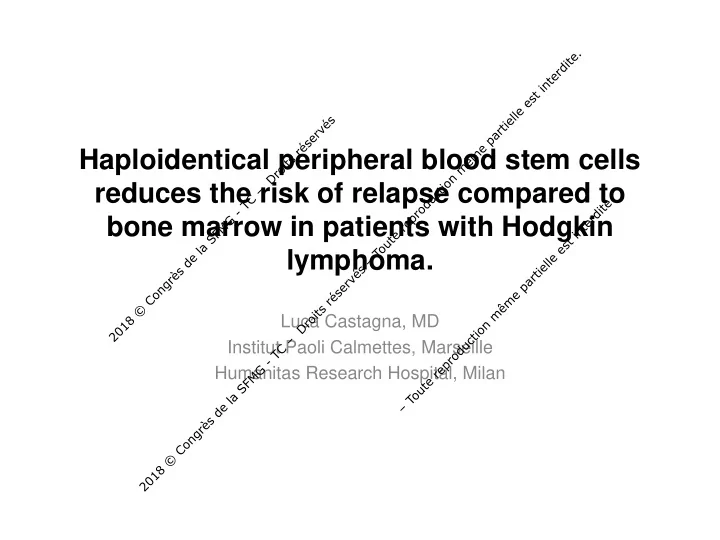

Haploidentical peripheral blood stem cells reduces the risk of relapse compared to bone marrow in patients with Hodgkin lymphoma. Luca Castagna, MD Institut Paoli Calmettes, Marseille Humanitas Research Hospital, Milan
Background • Haploidentical transplantation is effective alternative in HL patients without HLA identical donor • In retrospective studies, the relapse risk in HL patients seems to be lower after haploidentical transplantation with PT-Cy • In the original platform, BM is used as preferred stem cell source • The use of PBSC enhances the risk of GVHD
Allo-SCT program in lymphoma patients Marseille-Milan 2010-2017 308 91 analyzed HL 109 NHL 199 PBSC 38 BM 53 DLBCL 60 MCL 40 PTCL 60 FL 39
Patient characteristics Characteristics All BM PBSC p N N N N ° patients 91 (100) 53 (58%) 38 (42%) Median Age 31 (18-68) 31 (19-66) 33 (19-68) 0.609 Gender 0.066 M 52 (57%) 26 (49%) 26 (68%) F 39 (43%) 27 (51%) 12 (32%) Previous SCT No 12 (13%) 4 (8%) 8 (21%) 0.060 Yes 79 (79%) 49 (92%) 30 (79%) Disease status pre-Allo CR 58 (64%) 33 (62%) 25 (66%) 0.941 PR 23 (25%) 14 (26%) 9 (24%) SD/PD 10 (11%) 6 (11%) 4 (11%) Conditioning regimens NMAC 68 (75%) 33 (62%) 35 (92%) 0.001 RIC 23 (25%) 20 (38%) 3 (8%) HCT-CI 0-2 51 (56%) 37 (70%) 14 (37%) 0.002 ≥ 3 40 (44%) 16 (30%) 24 (63%) CMV serostatus Neg/Neg 79 (87%) 44 (83%) 35 (92%) 0.206 Others 12 (13%) 9 (17%) 3 (8%) Sex mismatch Others 74 (81%) 46 (87%) 28 (74%) 0.114 Female → Male 17 (19%) 7 (13%) 10 (26%) Median follow-up: 23 months (1-103)
Results: aGVHD 1.0 1.0 2-4 aGVHD 3-4 aGVHD All All 0.8 0.8 Cumulative incidence Cumulative incidence BM BM PBSC PBSC 0.6 0.6 p=0.3 0.4 0.4 28% p=0.8 0.2 0.2 21% 4% 0.0 0.0 3% 180 0 50 100 150 180 0 50 100 150 Days post Haplo-SCT
Results: moderate/severe cGVHD Days post Haplo-SCT 1.0 Cumulative incidence All 0.8 BM PBSC 0.6 0.4 p=0.6 0.2 9% 6% 0.0 0 200 400 600 730 Days post Haplo-SCT Moderate/severe cGVHD
Results: OS and PFS 2-yOS 1.0 BM 1.0 CR PBSC 1.0 PR SD/PD 0.8 74% 0.8 66% 0.8 Probability 77% 62% 0.6 0.6 Probability Probability 0.6 63% p=<0.0001 0.4 p=0.1 0.4 0.4 0.2 0.2 15% 0.2 0.0 0.0 0.0 0 200 400 600 800 1000 0 200 400 600 800 1000 0 200 400 600 800 1000 Days post Haplo-SCT Days post Haplo-SCT Days post Haplo-SCT 2-y PFS 1.0 1.0 1.0 BM CR PBSC PR PD/SD 0.8 0.8 0.8 69% 62% 58% 0.6 Probability Probability 0.6 0.6 Probability 54% 55% 0.4 0.4 0.4 p=0.1 p=0.001 0.2 0.2 0.2 10% 0.0 0.0 0.0 200 400 600 800 1000 600 800 1000 0 1000 0 200 400 600 800 400 0 200 Days post Haplo-SCT Days post Haplo-SCT Days post Haplo-SCT
Results: relapse incidence 2-y RI 1.0 1.0 BM 1.0 PBSC CR PR SD/PD Cumulative incidence 0.8 Cumulative incidence 0.8 0.8 Cumulative incidence p=0.3 p=0.0005 0.6 0.6 0.6 50% 36% 0.4 0.4 0.4 25% 22% 0.2 11% 0.2 0.2 18% 0.0 0.0 0.0 0 200 400 600 800 1000 0 200 400 600 800 1000 0 200 400 600 Days post Haplo-SCT Days post Haplo-SCT Relapse.Day
Multivariate analysis Characteristics Relapse p OS p PFS p NRM p Disease status CR 1 1 1 1 PR 5.11 (1.74-15.0) 0.003 1.92 (0.78-4.71) 0.1 1.88 (0.85-4.16) 0.1 0.42 (0.09-1.9) 0.2 SD/PD 35.6 (7.8-161.3) <0.00001 7.97 (3.23-19.63) <0.0001 8.93 (3.66-21.7) <0.0001 5.36 (1.53-18.77) 0.009 Graft Source BM 1 1 1 PBSC 0.28 (0.09-0.84) 0.024 0.33 (0.14-0.79) 0.014 0.43 (0.20-0.91) 0.028 HCT-CI 0-2 1 1 0.066 1 ≥ 3 2.84 (1.30-6.20) 0.009 1.91 (0.95-3.81) 2.59 (0.98-6.84) 0.053 Conditioning NMA 1 RIC 0.33 (0.98-1.15) 0.08
Conclusions • Haploidentical transplantation with PT Cy is effective in HL patients • The use of PBSC reduced the risk of relapse compared to BM • On the other hand, PBSC did not enhance the risk of acute and chronic GVHD • Finally, as expected the disease status plays a major role in the outcome.
Univariate analysis 2y-Relapse p 2y-OS p 2y-PFS p 2y-NRM p 2y-GRFS p Disease status CR 11% <0.001 77 <0.001 69 < 0.001 20 0.026 60 <0.001 PR 36 63 55 9 46 SD/PD 50% 15 10 40 10 Conditioning NMA 23 0.707 71 0.160 61 0.274 16 0.112 53 0.247 RIC 18 53 56 26 47 Graft Source BM 25% 0.333 62 0.076 56 0.125 20 0.460 48 0.141 PBSC 18% 74 62 20 54 Previous SCT No 25 0.461 56 0.532 60 0.988 15 0.421 50 0.780 Yes 21 69 59 20 51 CMV Others 21 0.696 67 0.256 58 0.657 21 0.309 50 0.634 Neg/Pos 27 83 65 8 56 Sex mismatch No 21 0.820 67 0.583 60 0.876 19 0.749 52 0.704 F → M 25 71 53 21 47 Sex Female 24 0.654 66 0.757 60 0.763 17 0.972 52 0.756 Male 21 68 57 21 50 HCT-CI 0-2 25 0.583 74 0.173 65 0.277 10 0.054 57 0.349 ≥3 19 57 50 32 42
Recommend
More recommend